What is an SDET?
An SDET, or Software Development Engineer in Test, is a crucial role in software engineering that combines software development with testing to ensure software quality. Originating from innovative tech practices, SDETs design automated testing frameworks, develop test cases, and write code to enhance software testability. This role facilitates seamless integration of quality assurance into the software development lifecycle, supporting rapid and reliable software delivery.
I’ve been asked many times to define the difference between a software tester, a QA engineer, a manual tester, and a software developer in test, so I decided to finally write a post on it.+
In this in-depth guide, you'll learn all about the role of an SDET. Read on to find out what are the roles and responsibilities, career path, salary, and skill set needed for this position.
Elevate your E2E testing skills with AI in 2026
INDEX
Demand for SDETs is Growing
Differences between SDET, QA, and Tester
Can Developers Even Test?
What is the difference between SDET and Tester QA?
Software Test Job Description Example
Common Software Tester QA Responsibilities
What are the roles and responsibilities of a SDET?
What does an SDET do? Common Tasks:
Here is an Amazon SDET job listing
SDET Salary – Pay Difference between a Tester and an SDET
Books for Wannabee SDET
Change in the Hiring Process for Testers
How can you improve your testing skills?
Demand for SDETs is Growing
I first heard of the role of SDET from Microsoft, where I believe it originated.
But I think now it’s the norm within most high–tech companies—especially the ones in and around Silicon Valley.
Although I think Microsoft has dropped this title, it lives in companies like Amazon and Google and in job postings.
You can also see the trend for the number of times the term “SDET” is searched on Google:
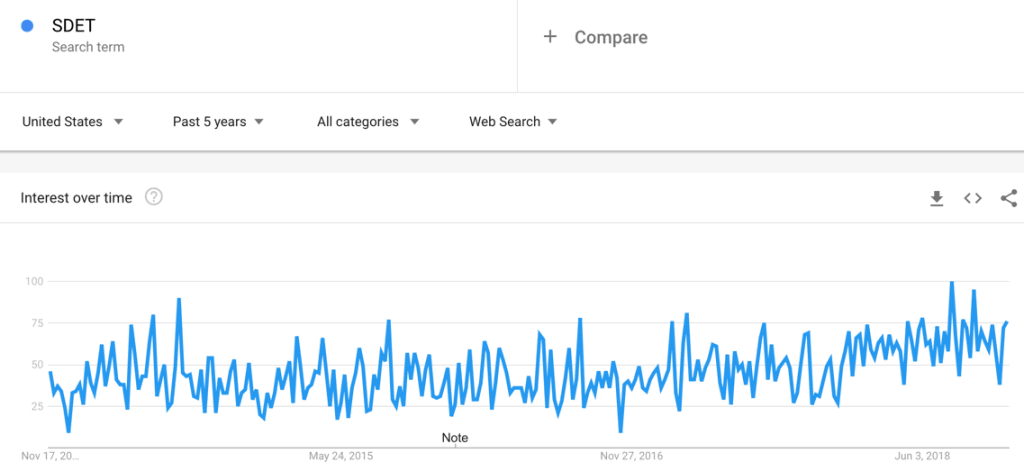
With the growth of Agile, DevOps, and Continuous Testing, the role of an SDET Developer in Test is on the rise.
With more and more companies shifting left in their software development lifecycle, the need to run tests and get quick feedback from the developers is critical.
Learn SDET Skills at Automation Guild
Differences between SDET Meaning, QA, and Tester
Because of these developer-like activities, a software development engineer requires a unique set of skills; someone who has testing skills, understands testing, and can also program.
Enter the role of an SDET.
Very often, SDET is involved in both white-box and black-box testing—all the way from helping create low-level unit tests to high-level activities like test planning, creating test cases, and manual software testing.
SDETs also have skills that make them perfect resources for creating test automation frameworks and tools. Many times they are part of a development team. They are also the ones that help select what might be the best test automation tools for their teams.
According to Rick Martin, a principal engineer and quality engineering practice manager, test automation is not just about automating tests. SDETs need to look at the entire software development lifecycle and work closely with developers and DevOps to build continuous integration pipelines. The collaboration and conversations around requirements, environments, data, and reporting are crucial.
I've also found that many excellent testers on a test team don't have the technical skills or desire to code.
That's fine.
But I think there's an opportunity for more SDET professionals at most companies to fill in the gap between developers and traditional testers.
Having a software development engineer in test as part of your developer's code reviews to make sure this is happening is crucial if you plan on having your developers focus on test-driven development.
Software developer engineers in test really are a hybrid-type of a role.
I’ve also found that many excellent testers on a test team don’t have the technical skills or desire to code.
That’s fine.
But I think there’s an opportunity for more SDET professionals at most companies to fill in the gap between developers and traditional testers.
Having a software development engineer in test as part of your developer's code reviews to make sure this is happening is crucial if you plan on having your developers focus on test-driven development.
Can SDET Developers Even Test?

Some folks will say that developers can’t test because test automation tool development and testing are two different skills that require two different systems of testing.
Alan Page, one of the most respected testers I know, doesn’t feel this is an issue.
In my interview with Alan on the testing lessons he learned at Microsoft he told me that almost every developer he knows can write very good functional tests—after being taught how to do so.
This is where someone in an SDET role can join in to help lead the team with their developer-centric testing efforts.
Alan went on to say, “I probably spent three months straight reviewing code—about two to three hours a day of all the check-ins for our team, just reviewing the test code and giving feedback. I don't need to do that anymore because I have developers who, for the most part, write pretty good tests, and they kind of get it now.
Of course, I think you need someone like an SDET to make sure when the developers are under pressure to deliver quickly that, they don't skimp on the testing quality.
What is the difference between SDET and Tester QA?
So how do you get hired as an SDET for one of the big tech companies? Or get promoted from a QA tester to a software development engineer?
One way to find out is to check job descriptions on hiring sites like indeed.com, Dice, or Simply Hired to find out what is the difference between a post for a QA tester vs an SDET.
For example, here is a generic job description and salaries I found on **Payscale
Software Test Job Description Example
In any software development lifecycle, a software tester plays a key role in the process.
Although many teams have moved to Agile, I know many testers still report to the quality assurance or engineering quality control department.
As a tester receives a new software build or function at any stage in the software development life cycle, they put the program through a variety of tests, documenting the software's response.
One of the key components in testing is documenting the steps performed in software testing; documentation is especially important since it is often key to helping programmers and software engineers discover coding problems.
Another key aspect of the tester's work is finding repeatable crashes and bugs in a program.
Common Software Tester QA Responsibilities
- Evaluate software application solutions for errors and stability
- Debug scripts and identify system flaws
- Perform both manual and automated testing strategies
- Create test plans
- Develop testing strategies and analysis for software programs
- Willingness to learn
Compare this to the software developer engineer test job description.
(resource **Payscale)
Difference between SDET, Test Engineer, and QA Tester
These three roles in the software testing domain are often used interchangeably, but they do have some key differences. Let's go through each of them.
- SDET (Software Development Engineer in Test): An SDET is a software professional with a hybrid skillset, combining expertise in software development and testing. SDETs are typically responsible for creating automated test frameworks, designing and implementing test cases, and writing code to improve the overall testability of the software. They are often involved in the entire software development process and collaborate closely with developers, applying their knowledge of programming languages, data structures, and algorithms to identify and fix issues in the code.
- Test Engineer: A test engineer is a role primarily focused on testing the functionality, performance, security, and other aspects of a software product. Test engineers design and execute test plans, test cases, and scripts manually or using automated testing tools. They are responsible for identifying and reporting software defects and working with developers to ensure that the product meets quality standards. Test engineers may specialize in different aspects of testing, such as functional testing, performance testing, or security testing.
- QA Tester (Quality Assurance Tester): A QA tester is responsible for ensuring that a software product meets the established quality standards, including functionality, usability, and performance. QA testers are involved in the testing process by executing test cases, reporting bugs, and verifying that issues are resolved before the product is released. While they may use automated testing tools, QA testers often perform manual testing to identify defects and ensure that the user experience is smooth and meets expectations. QA testers typically work closely with the development team, test engineers, and other stakeholders to identify and address issues throughout the software development lifecycle.
| Role | Primary Focus | Key Responsibilities | Automation/Manual |
|---|---|---|---|
| SDET | Software Development & Testing | – Develop automated test frameworks – Design & implement test cases – Improve the testability of software | Automation |
| Test Engineer | Testing various aspects of software product | – Design & execute test plans, cases & scripts – Identify & report software defects – Specialize in testing areas | Both |
| QA Tester | Ensuring software product meets quality standards | – Execute test cases – Report bugs – Verify issues are resolved – Collaborate with the development team | Manual |
According to Kuzzat Altay, the CEO of Cydeo, in today's agile world there is a growing need for cross-functional team members. Developers are expected to test and testers (SDETs) need development skills. He sees manual testing becoming more focused on exploratory testing, while automation handles regression and validation. SDETs need to work closely with developers, providing the requirements for automated tests based on the manual test cases. Having technical coding skills is becoming increasingly important for job security and income potential as a tester.
What are the roles and responsibilities of a SDET?
Software development engineers in test (usually abbreviated as SDETs), are software developers working within the testing team.
He or she has full access to code and carries a variety of responsibilities. One of the key things that set the SDET apart is his or her access to code; he or she actively participates in debugging and altering the code as necessary. In this capacity, at times, the SDET almost assumes something of a hybrid role between the developers and the testers. Much of their development time is creating or updating code for their test automation framework.
Besides functional automation, senior SDETs typically can also assist with unit testing, API testing, security testing, DevOps and performance testing, and stress test activities. They also are required to know what automation tool to use for each of these software testing activities.
Additionally, the SDET normally identifies areas within the program requiring further or varied testing, helps design and set these tests up, provides test data, and participates in administering them. An SDET also looks to identify ways end-users and consumers will work with the software and helps create the best experience possible for the intended user by identifying areas needing continued adjustment.
To work as an SDET, a person typically must possess an educational background in programming and computer science, typically with a bachelor's degree in computer engineering or a related field. SDETs typically gain practical experience working both in test automation tool development and quality testing or assurance as well. They typically work in a computer lab and development environment during regular business.
SDETS are also expected to be experts with testing tools, developing automated test and testing frameworks as well as have the domain knowledge to be able to create acceptance tests.
They also have skills commonly found for developers like programming experience, development experience, know object-oriented programming, understand all areas of the developed phase. They can also modify existing code and understand the technical architecture, software design, and the software development process.
Learn practical ways to integrate AI into your work
What does an SDET do? Common Tasks:
- Automate test cases using the same coding languages (Java, Javascript, C#, etc.) as their developers
- Collaborate with developers in reviewing unit test and integration results for coverage analysis
- Create a branching strategy and policies for high-quality automation deliverables
- Design & develop pipeline as a code for Continuous testing & continuous integration
pipeline to integrate automation scripts into CI/CD pipeline. - Selecting test frameworks for their teams
- Drive automation efficiencies and coverage effectiveness using different automation framework tools and techniques
- Review the development code to build an effective automation suite to cover technical and business integration automation coverage
- Design a real-time automation dashboard to measure build quality and provide feedback to the agile delivery team
- Mentor quality engineers on automation best practices and support automation backlog efforts
- Perform manual, exploratory, and automation scripts development efforts
- Ensure the test coverage and execution of Unit, Integration, Acceptance, System, Regression, UAT, Security, and Performance are met
- Design, implement, execute and debug information technology test cases and scripts
Of course, this is a generic job description.
But if you look for and view an actual open position for an SDET on a job board, you can see what a more specific job description looks like. (I also find it helpful to look at job descriptions even if I’m not looking for new employment just to make sure I’m working on the right skills to keep me employed.)
Here is an Amazon SDET job listing
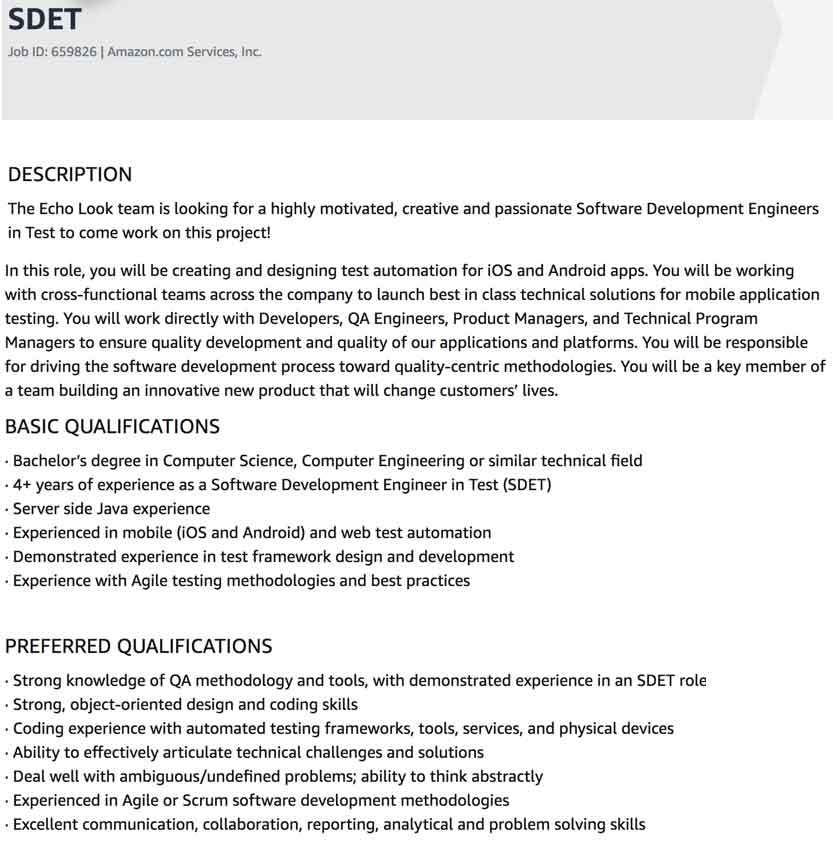
Here is another senior software developer in test position job requirement for a health care company:
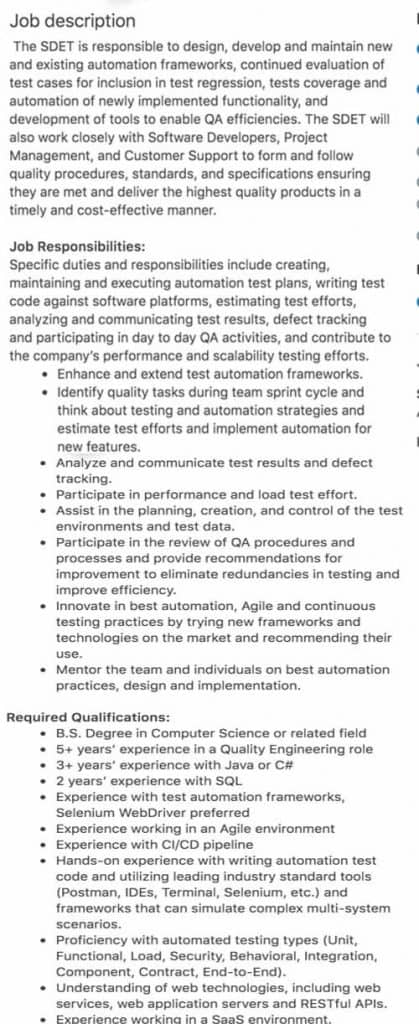
As you can see, both jobs require someone who has both testing and programming skills and can apply them to real-world situations. (Also, notice the emphasis on test automation tools for functional, API, and performance testing.)
If you’re looking for the different levels of software engineers at companies like Microsoft, Google, and Facebook, you can see them on the site Levels.
SDET Salary – Pay Difference between a Tester and an SDET
Besides skill differences between the two positions, you’ll also see a significant salary difference.
Once again, the site Payscale data shows that the national average for an SDET is $88,000/yr, and a Software Tester has an average yearly salary of $55,501. That’s a difference of over $32,000!
You can see the same pay difference looking at the UK job board ItJobsWatch:
If you look at the top job descriptions of skills that can bump up a tester’s pay, many of them are SDET-related skills like:
- Selenium Automation Test Tool
- .NET
- C# Programming Language
- Test Automation
- Java
Books for Wannabee SDET
Even though the book How We Test Software at Microsoft is slightly dated now, they have a nice SDET roadmap example of what Microsoft was using years ago to hire professional SDETs:
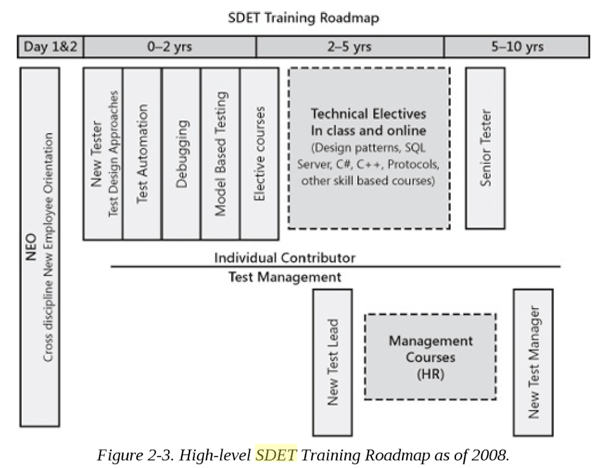
The book How Google Tests Software also contains a bunch of info on The Software Engineer in Test role, including a SET Workflow example.
Change in the Hiring Process for Testers
I’m not sure whether any of you have been on a testing job interview in a while, but that process has also changed.
Such an interview will often be for the role of a development engineer in test, so you get bombarded with programming-related questions.
I’ve heard from a number of folks that have been completely caught off-guard by these types of SDET-like interview questions.
If you haven’t been on a job interview in a long time, you may want to brush up on how to pass an automation testing coding interview before you start applying for a software development engineer position.
I know from my experiences that finding and hiring people with all the required skills can be difficult. So if you like the challenge of testing and enjoy developing code, a career as an SDET might be the perfect choice for you.
How can you improve your testing skills?
Of course, the key to keeping or obtaining a better job in a technology-based field is always working on your skills. If you are a tester or already an SDET, check out the yearly Automation Guild to make sure you stay up to speed with the latest tips, tools, techniques, and best practices you need to succeed with creating automation testing.




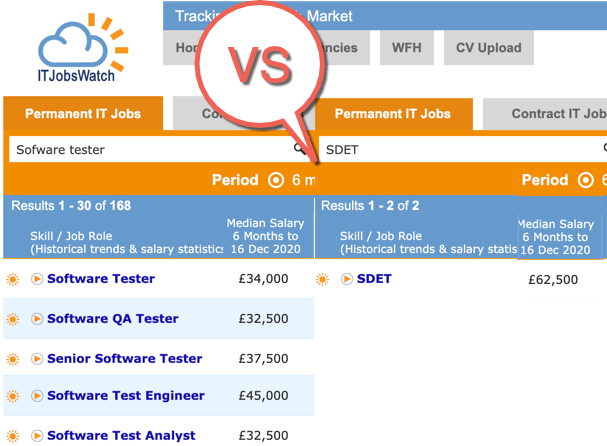






I have been an SDET for most of my career and for the most part this is an accurate summary. I converted from an entry level dev to SDET and after about 10 years a principal SDET at godaddy. Joe was right SDET type and kind of role is Seattle/Bay Area specific and the rest of the country is only seeing this kind of roles recently.
An SDET career has unique challenges on hand there is a bias only weak developers that didn’t cut it to make as SDE’s chose SDET career and on the other hand companies don’t pay SDETs as the same level as SDEs. SDET career also has unique growth opportunities because there are a very few of them and even very few good ones. By definition you are an outlier, so your impact can be great on the team. Also SDET career affords you flexibility and you can pick and choose for the most what you want to concentrate on.
Currently I am fortunate to be in one of those companies which values SDET career path and growth and if you’d like to join me, check out the job openings in my team https://lnkd.in/gSG62hk and https://lnkd.in/gZaQiXm
That’s a nice post Joe! A great comparison between the two positions from many angles :) Thanks for sharing
Joe, thanks for the good summary. This exactly matches my findings on the challenges with agile QA (or “testing in an agile delivery environment”) when you are left with traditional QA testers.
I also like that -unlike many other “thought leaders”- you do not actually blame QA testers for being unable to code. Funny enough, some time ago someone asked me
“If our testers can’t code but our developers can test – what do we need testers for, then?” and I replied “You know, you will need at least someone who actually reads and understands your requirements, don’t you?”.
I believe that we need a shift from calling everything “testing” into distinguishing between QA (something which is wholistically apllied and happens before, during and after development) and a testing discipline which goes hand-in-hand alongside development but is more of a technical role (what you call it “SDET”). These SDETs should not place a focus on execution of tests but rather delivery, maintenance and operation of testware. (While the latter could be nicely plugged into DevOps, aka DevTestOps or whatever you might call it).
The only thing we really need in order to bring this up to a whole new level is the awareness of stakeholders that this thing doesn’t mean “pay less for QA and get better results” but rather “spend your money misely” meaning: This is the future of testing – but it’s not coming to you for free.
Cheers, Thomas
You are just enough totally wrong to be dangerous to software development and test. We don’t need testers who can code, or even coders who can test (much less likely). We need testers who understand the problem domain and can grok what the users need in an era of agile and DevOps delivery, which an SDET is highly unlikely to do.
And guess what? I am a developer who can test, and a tester who can develop. Your superiority complex with SDET is setting testing back decades in an era where we desperately need testers who are intimate with the problem domain and user needs. All of the automation is great if we don’t really have users who need the software to accomplish their real jobs.
Very informative post.
I would like to suggest and update on the structure of how someone goes from a QA Analyst to an SDET role and how that looks.
I feel things are misconstrued that they are parallel. I had a manager compare the salary values of a QA level III to a SDET level III as being similar.
While I do believe there is a crossover (beginning as a tester) between being a QA to an SDET I feel that if you start at a QA level I you work your way through that and somewhere between the level II and level III you may be training for a level I SDET role.
There may be some rare cases out there, but would really like to know how others view this role progression. Bottom line I see a QA grow into an SDET role for someone just starting out as a tester.
Any thoughts?
I fulfill the role of an SDET, although that’s not my title. While I do automation, manual testing, etc., I also spend a lot of time writing software applications for the team. Somewhat of a tools dev role building applications (web app FE/BE, desktop apps, etc). I also cross into devops a bit, handling deployments and monitoring live servers. i used to use the title and tell people, “I’m doing the role of an SDET…” but now I just describe the work I do. I think it speaks more than a title. As for money… it’s all about negotiation. I can see why people might want to get into a SDET title, and SDET might be a bridge to development. However, people in QA can make more than an SDET or vice versa… depends on the company and how well you can sell your skills to management.
Such a great post ! Thanks for sharing with us.
Keep it up.
SDET